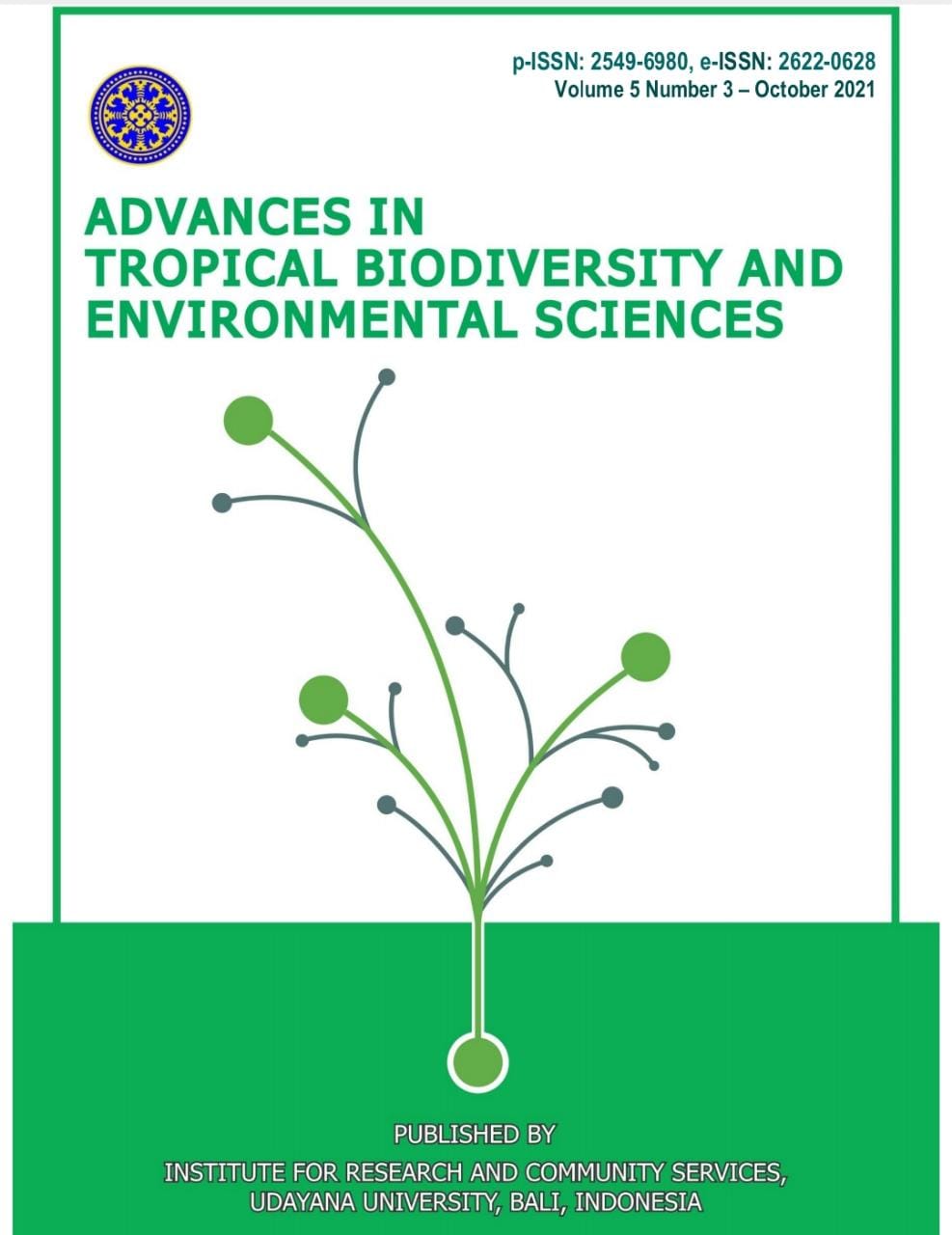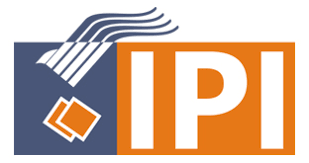Abundance of Plankton in the Waters of Geger Beach, Badung Regency, Bali
Abstract
Geger Beach is located in Peminge traditional village area, Sawangan, Nusa Dua, Bali which is a tourism area and there is seaweed cultivation managed by local people. Such human activity will affect the quality of the waters which will result in an increase in nutrients and organic matter which can further lead to changes in the structure of plankton. The purpose of this study is to find out the types of plankton and the abundance of plankton found in the waters of Geger Beach using the pour method. This research was conducted in March 2021. Sampling is conducted once a week at three observation points. The total phytoplankton species obtained as many as 32 species consisting of 6 classes, namely Bacillariophyceae (23 genera), Xanthophyceae (1 genus), Cyanophyceae (3 genera), Ulvophyceae (1 genus), Conjugatophyceae or Zygnematophyceae (2 genera), Coscinodiscophyceae (2 genera). The dominant type of phytoplankton found during the study was the Gyrosigma fasciola species in the Bacillariophyceae class. Meanwhile, the total zooplankton obtained by 11 species consisting of 5 classes, namely Maxillopoda (3 genera), Hexanauplia (3 genera), Magnoliopsida, Branchiopoda, and Copepoda (1 genus). The dominant type of zooplankton found during the study was the Cyclops sp. species in the Maxillopoda class. The average abundance of phytoplankton is 120 cells/l, while the average abundance of zooplankton is 20 cells/l. The average diversity value of phytoplankton is 2,7, while the diversity of zooplankton is 1,4. The average dominance index value of phytoplankton is 0,06, while the average zooplankton dominance index is 0,25.
Downloads
References
[2] Soeprobowati, T. R., &suedy, S. W. A. 2011. Lake Rawapening Phytoplankton Community, 19,7±30.
[3] Melay S, Rahalus KD. 2014. Zooplankton Community Structure in Mangrove Ecosystem in Ohoi/ Kolser Village, Southeast Maluku. Biopendix. 1(1): 101-110.
[4] Abida, I. W. 2010. Community Structure and Abundance of Phytoplankton in the Waters of the Porong Sidoarjo River estuary. Marine Journal, 3,36-40.
[5] Sugiyono. 2016. Quantitative, Qualitative and Mixed Methods Research Methods. Bandung: Alfabeta.
[6] Newell, G.E., and Newell, R.C. 1977. Marine Plankton a Practical Guide. London, United Kingdom: Departement of Zoology, Queen Mary Collage University.
[7] Conway, D.V.P., White, R.G., Hugues, D.C.J., Gallienne, C.P., and Robins. 2003. (1st ed.). Guide to The Coastal And Surface Zooplankton of The South Western Indian Ocean. United Kingdom: Marine Biological Association.
[8] Fachrul, M.F. 2012. Sampling Method bioecology. Jakarta, Indonesia: PT Bumi Aksara.
[9] Usman, M. S. J. D. Kusen. and J. R. S. L. Rimper. 2013. Plankton Community Structure in the Waters of Bangka Island, North Minahasa Regency. Journal of Tropical Coasts and Seas. 2 (1): 51-57.
[10] Munthe, Y. V., Riris, A, Isnaini. 2012. Community Structure and Distribution of Phytoplankton in the Breech Waters of South Sumatra. Maspari Journal. 4(1):122-130.
[11] Goldman CR., and Horne AJ. 1994. Limnology. Mc. Graw Hill Book Co. USA.
[12] Nurfadillah, Damar, and Adiwilaga. 2012. Phytoplankton Community in the Waters of The Fresh Sea Lake of Central Aceh Regency, Aceh Province. Depik, 1(2), 93–98.
[13] Faturohman, I., Sunarto, I. Nurruhwati. 2016. Correlation of Plankton Abundance with Sea Water Temperature Around Cirebon Power Plant. Journal of Fisheries and Marine Affairs. 8(1):115-122.
[14] Humaira R, Izmiarti, Zakaria I.J. 2016. Composition and Structure of Zooplankton Communities in the Litoral Zone of Lake Talang, West Sumatra. Proceedings of the National Seminar of the Indonesian Biodiversity Society. 2(1): 55-59.
[15] Maniagasi R, Tumembouw SS, Mundeng Y. 2013. Analysis of the Quality of Water Chemistry Physics in the Fish Cultivation Area of Lake Tondano, North Sulawesi Province. Aquaculture. 1(2): 29-37.
[16] Radiarta, I N., & Erlania. 2015. Index of Water Quality and Nutrient Distribution around Integrated Marine Cultivation in Ekas Bay, West Nusa Tenggara: Important Aspects of Seaweed Cultivation. Aquaculture Research Journal, 10(1): 141-152.
[17] Garno, Y.S. 2008. Water Quality and Phytoplankton Dynamics in the Waters of Harapan Island. Indonesian Hydrosfir Journal, 3: 87-94.
[18] An XP, Du ZH, Zhang JH, Li YP, Qi JW. 2012. Structure of the Zooplankton Community in Hulun Lake, China. Procedia Environmental Sciences. 13: 1099-1109.
[19] Rais FF, Djayus Y, Muhtadi A. 2015. Plankton Community Structure in Lake Pondok Lapan Naman Jahe Village Salapian District Langkat. Journal Aquacoastmarine. 9(4): 34-42.
[20] Yazwar. 2008. Plankton Diversity and Its Association with Water Quality in Lake Toba Parapat. Medan: Thesis Graduate School, University of North Sumatra.
[21] Amin M, Utojo. 2008. Composition and Diversity of Plankton Species in the Waters of Kupang Bay, East Nusa Tenggara Province. Torani Vol. 18 (2) : 129 – 135.
[22] Ludwig, J.A D and Reynolds, J.V. 1988. Statistical Ecology a Primer in Methods and Computing. John Wiley and Sons. New York.
[23] Aryawati, R. 2007. Abundance and Distribution of Phytoplankton in the Waters of Berau, East Kalimantan. Postgraduate. Bogor Agricultural Institute.
[24] Sachlan, M. 1972. Planktonologi. Correspodence Course Centre. Jakarta.
[25] Barus, T.A. 2004. Introduction to Limnology: The Study of Terrestrial Aquatic Ecosystem. USU Press, Medan.
[26] Kristianto, P. 2004. Industrial Ecology. PETRA Christian University, Surabaya. ANDI. Yogyakarta.
[27] Karyono dan Pandi. 1977. Several Observation on the Problem of Microcystis Algae Explosion in Relation to Water Quality. Journal of Ecology and Development No. 5 of 1977. 110-117 p.
[28] Zulfia, N. dan Aisyah. 2013. The Trophic Status of the Pening Swamp Waters in Terms of Nutrient Content (NO3 and PO4) and Chlorophyll-a. Bawal. 5(3): 189-199.
[29] Malaha, K.P. 2004. The Level of Water Fertility Based on the Nutrient Content of Nitrate (N) dan Phosphate (P) in the Waters of the River Balandete, Kolaka Regency. Essay. FPIK. UNHALU. Kendari..
[30] Effendi, H. 2003. Water Quality Assessment: For the Management of Aquatic Resources and the Environment. Yogyakarta: Kanisius.













